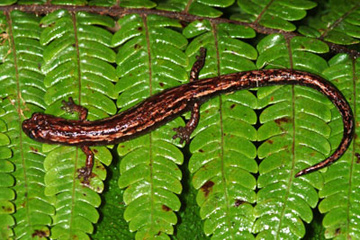Salamanders in Central America — like frogs, toads, and other amphibians at sites around the world — are rapidly and mysteriously declining, report researchers writing in the journal Proceedings of the National Academy of Sciences. Disturbingly, salamanders are disappearing from protected areas and otherwise pristine habitats.
The researchers, led by Dr. David Wake of the University of California at Berkeley, conducted surveys of prime salamander habitat in Mexico and Guatemala and found steep losses since the 1970s.
“We document major declines of many species of salamanders at several sites in Central America and Mexico, with emphasis on the San Marcos region of Guatemala, one of the best studied and most diverse salamander communities in the Neotropics,” write the authors. “Profound declines of several formerly abundant species, including 2 apparent extinctions, are revealed.”
Overall the average number of salamanders documented by researchers per visit over the course of the surveys fell from nearly 80 in the 1970s to 1.8 between 2005 and 2007, a drop of 98 percent. Where continuous data is available, the crash in salamander populations correspond to declines among frogs between the mid-1970s and early 1980s.
The authors note that salamander populations in mid- to high elevation forests have been particularly affected.
“The results of our surveys indicate a collapse of the upper cloud forest and high elevation salamander assemblages at most sites and demonstrate changes in abundance at most sites surveyed.”
 A paratype of Bolitoglossa gomezi, a species of salamander discovered in 2007 by David Wake and colleagues in the mountainous Costa Rica-Panama border region. Photo by Dr. Gunther Kohler. |
The researchers do not know yet what is causing the decline, though they suspect a human link. Deforestation of lowland areas, as well as regional climate change, can influence cloud formation and moisture at altitude, making it more difficult for some salamanders to persist. Ground-dwelling salamanders, the type that has seen the most significant decline, are particularly vulnerable to seasonal dryness.
“The most drastic declines in encounter rate of salamanders on the San Marcos transect occurred in terrestrial species, which do not use arboreal bromeliads as refuges. These species would be expected to respond more directly to changes in climate, particularly changes in humidity and precipitation, because they lack the moist, buffered microenvironment that bromeliads provide,” they explain.
“Cloud water provides an important source of moisture in tropical montane cloud forests during the dry season, when salamanders would be expected to be under the highest physiological stress; most cloud forest habitats contain little or no standing water, and plethodontid salamanders depend on adequate moisture for surface activity because of their permeable skins.”
The authors note that modeling by Alan Pounds and colleagues suggests that the conditions for salamanders could worsen with large-scale warming, eventually dooming arboreal salamanders as well.
The researchers have not ruled out another potential driver of localized extinction among salamanders — the chytrid fungus that is killing amphibians around the world — but have yet to find any evidence of the pathogen affecting salamanders in the area.
Other researchers say that pesticide use may specifically be affecting montane amphibian populations in Central America. In January 2007 a study led by Frank Wania of the University of Toronto found that pesticides used in lowland areas are carried by air currents to higher elevations where they are they precipitated out as rain when the air cools. The chemicals — especially the insecticide endosulfan and fungicide chlorothalonil — then accumulate in the ecosystem, potentially affecting montane forest biodiversity.
While the Wake and colleagues didn’t dwell on the potential impact of pesticides, they conclude that determining the proximate cause of declining salamander populations will be key to conserving them.
“Until the forces causing these declines are identified, however, an effective conservation strategy cannot be devised. Protecting habitat, although important, is insufficient to conserve populations of many of these species.”
CITATION: Sean M. Rovito, Gabriela Parra-Olea, Carlos R. Vásquez-Almazán, Theodore J. Papenfuss, and David B. Wake. Dramatic declines in neotropical salamander populations are an important part of the global amphibian crisis. PNAS Early Edition for the week of 9 Feb 2009.
 |
Bad news for frogs; amphibian decline worse than feared
(4/16/2007) Chilling new evidence suggests amphibians may be in worse shape than previously thought due to climate change. Further, the findings indicate that the 70 percent decline in amphibians over the past 35 years may have been exceeded by a sharp fall in reptile populations, even in otherwise pristine Costa Rican habitats. Ominously, the new research warns that protected areas strategies for biodiversity conservation will not be enough to stave off extinction. Frogs and their relatives are in big trouble.
Salamanders dying due to common pesticide
(3/25/2007) Atrazine, one of the most widely used pesticides in the United States, may be killing salamanders, according to American biologists writing in the journal Environmental Health Perspectives.